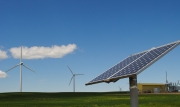A national carbon price should come as no surprise to anyone in Canada. An economy-wide price on carbon is the cornerstone of a comprehensive climate policy, and once again Alberta leads the way with its carbon levy, announced in May.
Economists consistently say businesses and individuals will be motivated to cut carbon pollution if they are given a financial incentive that grows over time. In short, that means a carbon tax. The federal government has decided to allow provinces to design their own carbon pricing systems and manage the revenue in a way that maximizes opportunities and addresses competitiveness, while protecting citizens, which is exactly what Alberta is doing.
Those who are vocal in their opposition to a price on carbon, or seek an exemption from it, offer little in the way of alternatives. Typically, they prefer to make alarming claims concerning the cost of the carbon levy to Albertans. Yet the alternatives to a price on carbon are prescriptive regulations and higher costs for compliance. Exempting sectors of the economy from the levy neutralizes the effect of the carbon price in terms of creating a clear incentive to reduce emissions.
In raising the alarm over the potential cost of the tax to individuals, critics completely ignore the rebate that will more than cover the cost of the carbon levy on the fuel Albertan’s use to drive and heat their homes. This is roughly $360 for a family of four in 2017, rising to $540 in 2018. It will be fully rebated to the majority of Albertans, with those who use less actually coming out ahead.
Low-income consumers typically use less energy than the rest of the population meaning the average rebate will more than cover the carbon levy they pay. For example, an average Albertan household making $60,000 or less per year would owe nothing and could actually see an extra $40-$60 in their pockets in 2017. A middle-income household that reduces its overall use by just 10 per cent would see their costs for the entire year range between $5 and a savings of $20. They also come out further ahead with less money going to energy overall, and they are protected from future increases in energy market prices.
The other imaginary costs come from a pan-Canadian study on a carbon levy that looks nothing like Alberta’s policy. The author of that study made it clear that the results do not apply. The research considered a policy without rebates. Applying that research to Alberta ignores basic facts about economic trade that will keep prices from rising. But despite having the professor clearly explain the errors, people continue to make these claims and cite this study.
The real “indirect” costs, changes in the price of food or other goods, have been estimated at $70-$105 per year for the average household — leaving low income households more than covered by the rebates and modest costs for middle income households.
The money collected from the carbon levy will either be given back to Albertans or invested in projects to further reduce greenhouse gases. Budget 2016-2017 shows a portion of the revenues will be used to offset the impact on low and middle-income households by providing them with consumer rebates that cover the full cost of the carbon levy. Low-income Albertans will have more than the full cost of the carbon levy rebated to them, while middle class households will pay only $10-$35 for the entire year. Those who reduce their emissions by taking action will end up ahead. Under this system, all Albertans have an incentive to reduce emissions.
Opponents also claim people cannot change their behaviour and therefore a carbon price will have little effect. The reality is there are examples from other jurisdictions that show people do respond to a carbon price by making changes to lower costs now and to avoid repeatedly paying a price on carbon over the longer term. They don’t have to do it alone either. Revenue from the levy will be used by the Energy Efficiency agency to help Albertans take measures like replacing windows and using high efficiency furnaces to increase energy efficiency in homes and businesses. Limiting the rebate to the additional cost faced by low and middle-income consumers ensures additional money needed to make investments in reducing emissions is available. These revenues can be used to support energy efficiency, renewable energy, and clean technology. In Alberta’s case it is also being used as support for small businesses.
Alberta is taking its climate change fate into its own hands, before the federal government imposes a plan on the province. Now is not the time for misleading information fuelled by a lack of actionable alternatives. The truth is simple: the carbon levy and rebate system will protect Albertans from extra costs and actually leave most coming out ahead.







